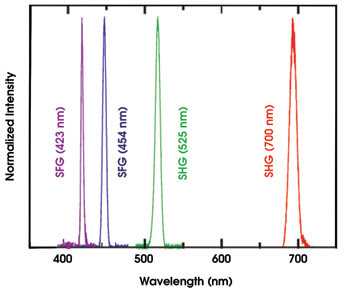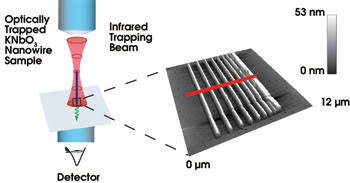
Scanning Light Microscopy Uses Nonlinear Properties of KNbO3 Nanowires
Lauren I. Rugani
Efficient second harmonic generation and wave mixing make potassium niobate (KNbO3) nanowires ideal sources of tunable, coherent light and instruments for subwavelength microscopy, according to Peidong Yang and his group from the University of California, Berkeley, from Lawrence Berkeley National Laboratory in California and from Sony Corp. in Kanagawa, Japan.

Sum frequency generation (SFG) and second harmonic generation (SHG) are two nonlinear optical processes that occur within KNbO3 nanowires, generating new wavelengths that span across the visible spectrum. Images reprinted with permission from Nature.
Two photons with the same angular frequency can be converted through a nonlinear crystal polarization process inside the nanowire into a single photon, with twice the energy and half the wavelength as the originals, while photons with different frequencies can be combined through sum- or difference frequency generation; tuning the input frequency allows the nanowires to generate light throughout the visible spectrum.
This phenomenon enabled the researchers to use a single laser as a trapping beam and for second-harmonic-wave generation in a technique called scanning light microscopy. When a 1064-nm beam from a continuous-wave infrared laser trapped KNbO3 nanowires between two objectives, light radiated from the distal end of the nanowires at ~532 nm, demonstrating second harmonic generation in agreement with the expected value. Similar investigations with zinc oxide and silicon nanowires — which do not possess KNbO3’s high nonlinear optical coefficient — produced no visible light.

The second harmonic wave from an optically trapped nanowire is scanned over a sample test pattern of gold stripes. An intensity map reveals decreases in detected transmission that accurately represent the position of each gold feature and demonstrate the spatial resolution of the system.
To test the ability of the nanowires to image objects, the team scanned the emitted beam over a sample pattern of gold stripes, each 200 nm wide and 50 nm thick, separated by progressively finer distances decreasing from ~1000 to ∼200 nm. A decrease in detected second harmonic transmission was observed each time the wire passed over a gold mark, creating an intensity map with a spatial resolution dependent on the nanowire diameter. The nanowires fabricated by the group have widths ranging from 40 to 400 nm, but Yang noted that the current spatial resolution of the technique lies at 200 nm, which they hope to improve.
The nanowire probe also functions in fluorescence mode, where the distal end of the trapped nanowire is brought into contact with a 1-μm polystyrene bead containing the fluorescent dye POPO-3. The emitted second harmonic wave acts as the primary source of excitation for two-photon fluorescence, resulting in orange emission at the contact point between the bead and the nanowire. Removal of the nanowire reduced the fluorescence by more than 80 times.
Because the technique is still in its early stages, the investigators are working to interpret readouts such as the fraction of excitation light that is transmitted and the mechanical deflection of the nanowire during scanning. They also plan to adapt the signal-processing algorithms used in atomic force microscopy and near-field scanning optical microscopy to their technique. They envisage scanning light microscopy extending to parallel excitation arrays that could prove useful in applications such as microfluidic chambers.
Nature, June 28, 2007, pp. 1098-1101.
Published: September 2007